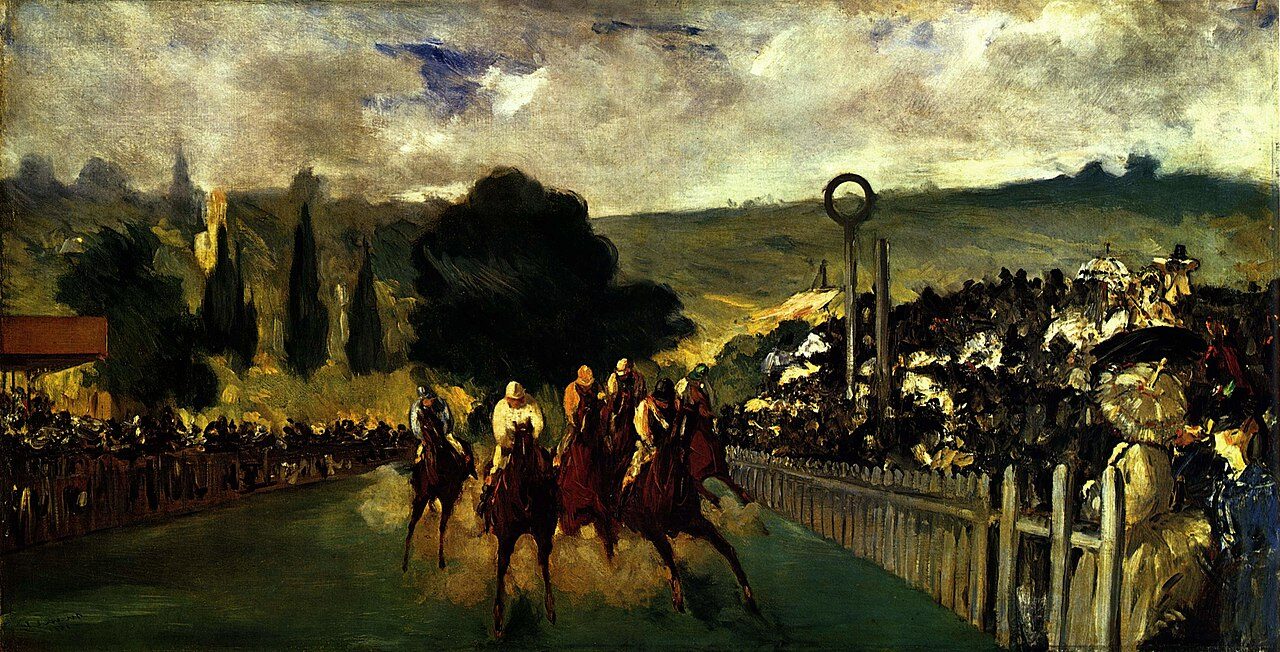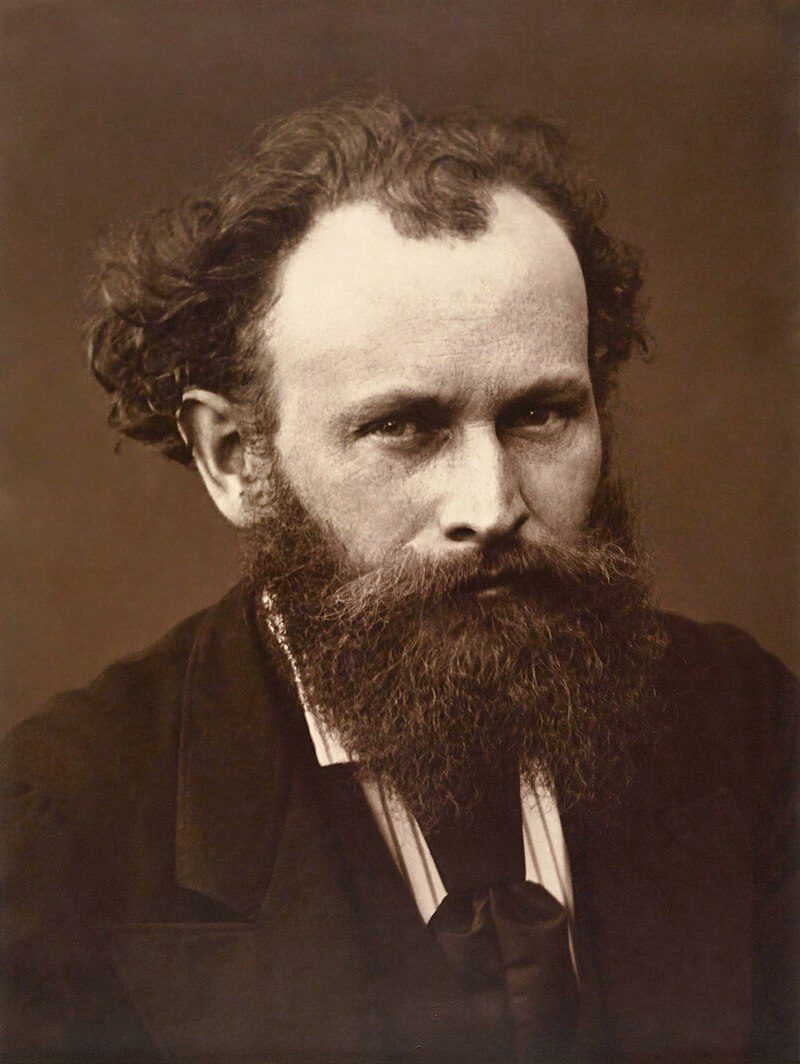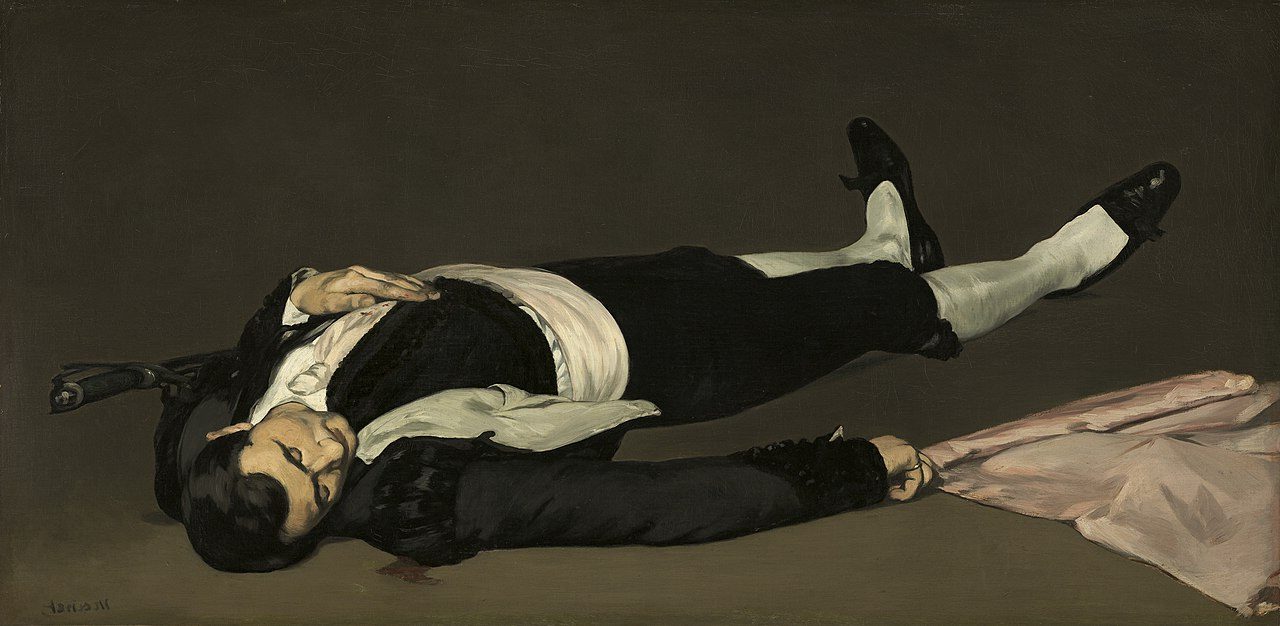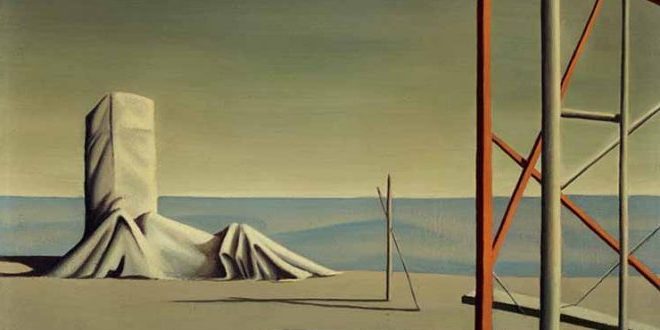Édouard Manet: Painter Who Revolutionized Modern Art
Born: 23 January 1832, Paris, Kingdom of France
Death: 30 April 1883, Paris, France
Art Movement: Realism, Impressionism
Nationality: French
Influenced By: Frans Hals, Velázquez, and Francisco José de Goya
Teacher: Thomas Couture
Édouard Manet: Painter Who Revolutionized Modern Art
Biographical Overview
Édouard Manet lived a relatively short but artistically revolutionary life from 1832 to 1883. His journey from a privileged Parisian upbringing to becoming one of the most influential painters in Western art transformed how future generations would approach painting.
Early Life and Education
Édouard Manet was born on January 23, 1832, into an affluent Parisian family. His father, Auguste Manet, worked as a judge and expected his son to pursue a legal career.
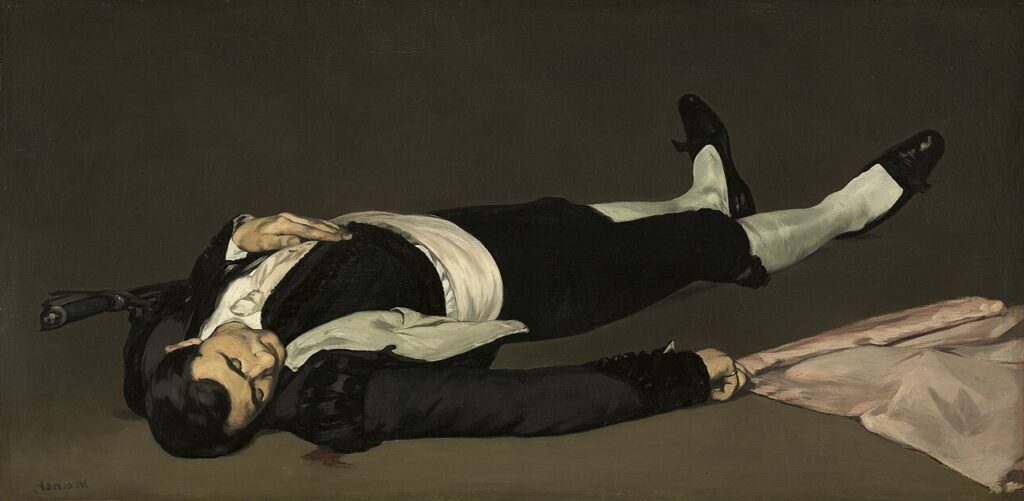
Dead Matador by Édouard Manet (1864–65)
Young Manet showed artistic talent early but faced parental opposition to his creative interests. After failing the naval academy entrance exam, he finally received permission to study art.
In 1850, he entered the studio of Thomas Couture, a respected academic painter. Manet studied under Couture for six years, though their relationship was often strained due to Manet’s desire to break from traditional techniques.
During this period, Manet also traveled extensively through Europe, studying the Old Masters. He was particularly influenced by Spanish painters like Velázquez and Goya, whose work would later inspire his distinctive style.
Career Beginnings
Manet established his independent studio in 1856 after leaving Couture’s tutelage. His early works showed technical skill but sparked controversy for their modern subjects and bold execution.

The Luncheon on the Grass (Le Déjeuner sur l’herbe) – Édouard Manet (1863)
In 1863, his painting “Le Déjeuner sur l’herbe” (Luncheon on the Grass) shocked the Paris art world with its depiction of a nude woman casually picnicking with clothed men. This work was rejected by the official Salon but displayed at the alternative “Salon des Refusés.”
His 1865 painting “Olympia” created an even greater scandal. The work portrayed a nude courtesan staring directly at viewers, challenging conventional artistic traditions and social norms.
Despite criticism, Manet attracted supporters among progressive writers and artists. He became a central figure in Parisian intellectual circles, regularly meeting with future Impressionists at the Café Guerbois.
Later Life and Death
The Franco-Prussian War (1870-1871) interrupted Manet’s career when he served as a military officer. After the war, his style evolved as he experimented with lighter palettes and outdoor painting techniques.
Though often associated with Impressionism, Manet never exhibited in any Impressionist exhibitions. He maintained his goal of achieving recognition at the official Salon, where he finally received positive recognition in the late 1870s.
Manet’s health deteriorated significantly in his final years due to complications from syphilis. His mobility became limited, forcing him to create smaller works and still lifes.
On April 30, 1883, Manet died in Paris at age 51 after having his left foot amputated due to gangrene. His funeral was attended by artistic luminaries including Claude Monet and Émile Zola, signaling his importance to French cultural life despite years of controversy.
Artistic Style and Influence
Manet’s distinctive artistic approach broke traditional rules while bridging classical painting and modernism. His bold techniques and subject choices significantly shaped late 19th-century art and influenced generations of painters that followed.
Technique and Innovation
Manet rejected traditional modeling and shading methods in favor of flatter, more direct painting techniques. He often used bold brushstrokes and stark contrasts between light and dark areas. This approach created a sense of immediacy in his work.
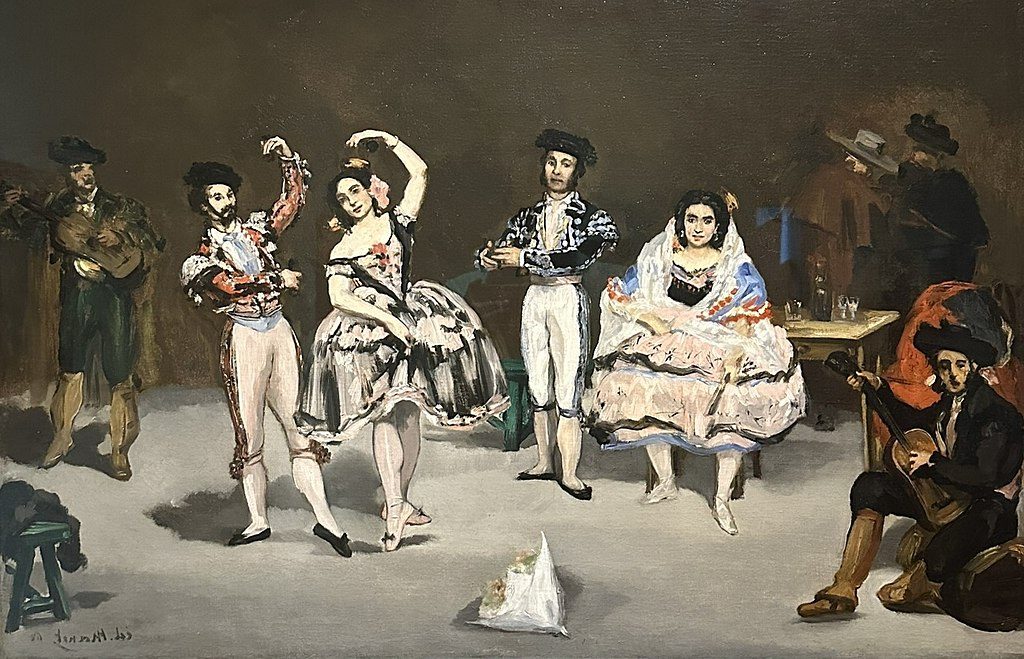
Spanish Ballet by Édouard Manet (1864)
His compositions frequently featured contemporary subjects in unconventional poses. “Olympia” (1863) and “Luncheon on the Grass” (1863) shocked audiences by presenting modern figures in classical compositions.
Manet’s technique emphasized visual truth over idealization. He painted what he actually saw rather than what academic traditions dictated. This honesty in representation was revolutionary for his time.
Impressionism and Beyond
Though often associated with Impressionism, Manet never officially joined the movement. His work served as a critical bridge between academic painting and the emerging Impressionist style.
Key characteristics of his influence on Impressionism included:
- Focus on modern life subjects
- Use of brighter color palettes
- Emphasis on light effects
- Rejection of traditional finishing techniques
Younger artists like Claude Monet and Pierre-Auguste Renoir admired his boldness. They adopted his interest in contemporary scenes but took his innovations further with looser brushwork and plein air painting.
Notable Contemporaries
Manet maintained complex relationships with fellow artists of his era. He was close friends with Edgar Degas, with whom he shared an interest in urban subjects and theatrical settings.
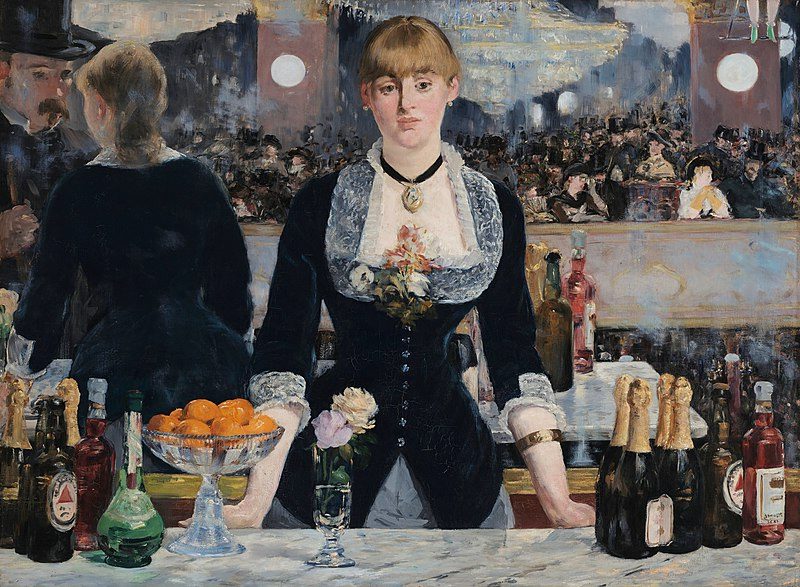
A Bar at the Folies-Bergère (Un Bar aux Folies-Bergère) – Edouard Manet (1882)
Berthe Morisot, who later married Manet’s brother, became one of his most important artistic connections. Their mutual influence is evident in their respective painting styles and subject choices.
The critic Émile Zola vigorously defended Manet’s work, recognizing its revolutionary importance before most others. Their friendship sustained Manet through years of harsh public criticism.
Manet’s studio became a gathering place for progressive artists and intellectuals. These connections helped spread his artistic ideas and cement his influence on modern art history.
Major Works and Legacy
Manet created several groundbreaking paintings that challenged artistic traditions and influenced generations of artists. His work bridged classical techniques with modern subjects, helping to launch the Impressionist movement despite his own complex relationship with the group.
Iconic Paintings
“Olympia” (1863) stands as one of Manet’s most controversial masterpieces. This painting of a nude courtesan staring directly at viewers shocked Paris with its unflinching realism and modern approach to a classical theme.
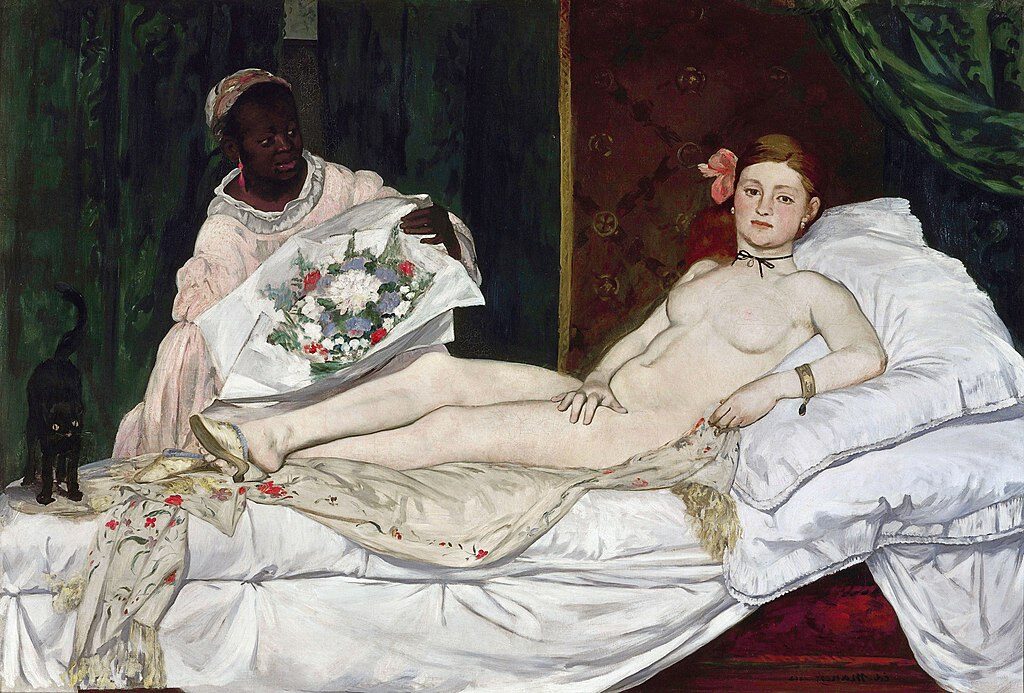
Olympia (1863–1865) by Edouard Manet
“Le Déjeuner sur l’herbe” (1863) caused similar outrage by placing a nude woman in a contemporary setting with fully-clothed men. The casual scene violated academic conventions about how classical nudes should be depicted.
“A Bar at the Folies-Bergère” (1882), one of his final major works, shows a barmaid with a complex mirror reflection behind her. The painting’s ambiguous perspective and psychological complexity continue to fascinate scholars.
Manet’s portraits, like “Berthe Morisot with a Bouquet of Violets” (1872), demonstrate his keen observation and technical brilliance.
Exhibitions and Recognition
The Paris Salon rejected many of Manet’s most important works. His paintings appeared in the controversial Salon des Refusés in 1863, where rejected artists could display their work.
Despite frequent criticism, Manet never gave up seeking official recognition. He finally received a second-class medal at the Paris Salon in 1881, near the end of his life.
Émile Zola, the famous writer, defended Manet’s work in print. Their friendship resulted in Manet’s notable 1868 portrait of Zola surrounded by Japanese art and references to Manet’s own controversial paintings.
During his lifetime, Manet built a small but dedicated following among progressive artists and intellectuals. Full public appreciation of his genius came only after his death.
Influence on Modern Art
Manet’s technical innovations transformed painting. He flattened perspective, emphasized bold brushwork, and reduced shadows—techniques that inspired the Impressionists and later artists.

Music in the Tuileries by Edouard Manet (1862)
His choice of contemporary subjects over historical or mythological themes helped liberate artists to paint modern life. This approach influenced not just Impressionism but virtually all modern art movements.
Young painters like Claude Monet and Pierre-Auguste Renoir admired Manet, though he kept his distance from their group exhibitions. His studio became an important meeting place for progressive artists.
Pablo Picasso and other 20th-century innovators acknowledged their debt to Manet’s visual experimentation. His willingness to challenge conventions and face public criticism provided a model for avant-garde artists throughout modern art history.
Frequently Asked Questions
Édouard Manet’s artistic legacy raises many questions about his techniques, influences, and contributions to art history. His revolutionary approach challenged conventions and shaped modern painting in profound ways.
What are the most significant contributions of Édouard Manet to the modern art movement?
Manet broke with academic traditions by rejecting idealized subjects and embracing contemporary life. His flat painting style and bold brushwork challenged the illusionistic space that dominated previous art periods.
He introduced modern subjects into fine art, depicting cafés, street scenes, and everyday people rather than mythological or historical themes. This shift toward the present moment became a hallmark of modernism.
Manet’s emphasis on the flatness of the canvas and the materiality of paint influenced later movements like Impressionism and Post-Impressionism. His work “Le Déjeuner sur l’herbe” challenged conventional composition and subject matter rules.
How did French society and politics of the 19th century influence Manet’s artwork?
The rapid modernization of Paris under Baron Haussmann’s redesign provided Manet with new urban subjects and scenes. His paintings captured the changing social landscape of cafés, boulevards, and entertainment venues.
The political turbulence of the Second Empire and the Paris Commune affected Manet’s choice of subjects. His painting “The Execution of Emperor Maximilian” reflected the political tensions of French intervention in Mexico.
Manet’s depictions of class differences reflected the social stratification of 19th century France. He portrayed both the bourgeoisie and working class, often highlighting the contrasts between them.
Can you explain the controversy surrounding Manet’s painting ‘Olympia’ and its impact on art history?
“Olympia” caused a scandal when exhibited at the Paris Salon of 1865 because it depicted a nude prostitute gazing directly at viewers. The public was shocked by her confrontational stare and the painting’s flat, unidealized style.
The black servant in the background highlighted racial and class dynamics, making the painting politically charged. Critics found the work “vulgar” and “immoral” for its honest portrayal of contemporary sexuality.
This painting revolutionized the nude genre by replacing mythological pretexts with stark realism. Art historians now consider “Olympia” a pivotal work that challenged the male gaze and traditional power dynamics in art.
What are some of the key characteristics of Manet’s painting style and technique?
Manet used bold, visible brushstrokes that drew attention to the surface of the canvas. He often employed strong contrasts between light and dark areas, creating a flattened pictorial space.
His palette featured strong blacks unlike the Impressionists who later avoided them. He reduced shading and modeling, sometimes using outlines to define forms rather than gradual transitions of tone.
Manet often cropped his compositions in ways that suggested the influence of photography. His paint application was sometimes thin and fluid, while other areas showed thick, textured brushwork.
How did Manet’s relationship with other impressionist artists affect his work and vice versa?
Though Manet never exhibited with the Impressionists, he maintained close friendships with artists like Monet and Renoir. These relationships exposed him to plein air painting techniques and lighter palettes.
Manet influenced the Impressionists through his modern subject matter and unconventional compositions. His focus on contemporary life and rejection of academic rules helped younger artists break with tradition.
The Impressionists’ experiments with light and color eventually influenced Manet’s later works. In paintings like “Boating,” he adopted a brighter palette and more visible brushwork similar to Impressionist techniques.
What role did Édouard Manet play in the transition from Realism to Impressionism?
Manet served as a crucial bridge between Realism and Impressionism. He maintained Realism’s focus on contemporary subjects while developing formal innovations that inspired the Impressionists.
His emphasis on the flatness of the picture plane and the materiality of paint challenged traditional illusionism. These qualities became important aspects of Impressionist and later modernist painting.
Manet’s outdoor scenes and café paintings opened up new subject matter for the Impressionists. Though he maintained studio practice throughout his career, his late garden paintings showed increasing affinity with Impressionist techniques.

